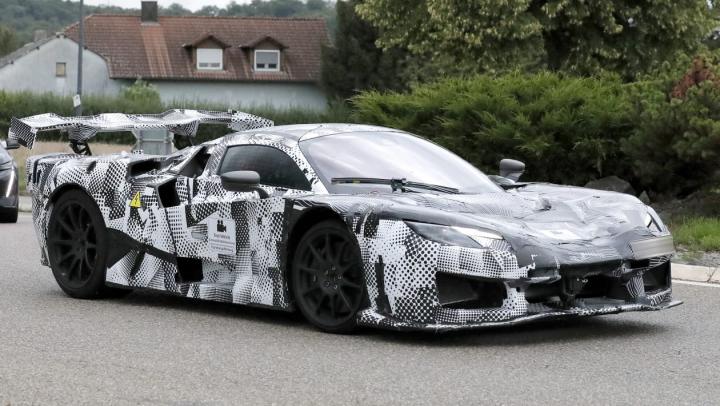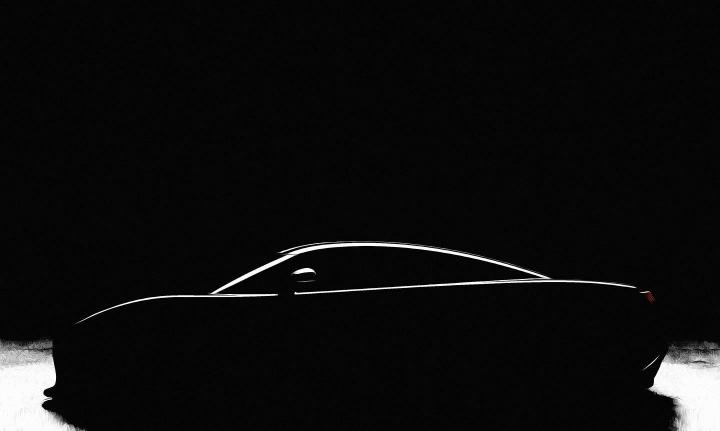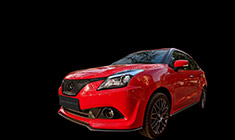News
Ferrari's upcoming hypercar could downsize to a V6 hybrid
The upcoming Ferrari F250 could be the brand's first four-wheel-drive hypercar.
Ferrari has been working on its all-new hypercar, codenamed F250, for nearly a year now. The new hypercar from the Italian brand is a replacement for the LaFerrari, which came out in 2013.
As per reports, the new Ferrari hypercar will borrow a lot of elements from its F1 & Le Mans technology to make the ultimate road car. The prototype, spied on multiple occasions, gives us a glimpse of what to expect. It shows the car sitting low down, with plenty of air vents in the front and a large wing, along with a massive diffuser at the rear. Further to this, the new hypercar can also be seen with narrow cabin proportions and several air channels along the bodywork.
However, reports also suggest that the new hypercar could come fitted with a 3.0-litre V6 derived from the brand's 296 GTB, as well as, on the Ferrari 499P Le Mans car. The V6 though will be paired with a hybrid power unit. This is in line with the brand's pledge to offer tech from its F1 & Le Mans cars, both of which are powered by V6 engines. Reports also state that considering the 296 GTB itself makes 819 BHP, the upcoming hypercar could offer well over 1000 BHP of power output.
Also, with the V6 engine paired with a powerful hybrid setup potentially powering the front wheels, the upcoming Ferrari F250 could be the brand's first four-wheel-drive hypercar.
Source: EVO UK
- Tags:
- Indian
- Hypercar
- International
News
Bugatti Chiron successor to be unveiled in 2024 with V8 hybrid
The Chiron successor hypercar will continue to feature all the iconic design cues of the brand.
Bugatti has confirmed that its all-new hypercar will be unveiled sometime in 2024, with production expected to commence in 2026.
The all-new hypercar will be a successor to the Bugatti Chiron and will come powered by a V8 hybrid powertrain, ditching the brand's famed W16 engine. The new powertrain will make use of the electrical expertise of Croatian brand Rimac, which merged with the French hypercar maker back in 2021.
Bugatti's head of design, Achim Anscheidt, stated in an interview that the car's design was ready to go. He confirmed that the prototype tooling was delivered a few months ago, with the production tooling expected to be delivered in a couple of months. The Bugatti Chiron successor will be Anscheidt's final project with the hypercar brand, as he will be stepping down from the role after being with the company for 19 years.
Coming back to the car itself, the Chiron successor hypercar will continue to feature all the iconic design cues of the brand. This includes the C-shaped side bodywork and the horse-shoe grille up front. However, shifting from a W16 to a V8 hybrid will see the new Bugatti hypercar being built around a completely new chassis. Inside, the new hypercar is expected to have a familiar feel featuring an elegant design & ornate controls. One new addition though, will be a large central touchscreen infotainment display which has been absent on the Chiron and all its iterations over the years.
Reports state that the new Bugatti hypercar will be costlier than even the $5 million limited-version Mistral. Post the launch of the Chiron successor, Bugatti is also expected to turn its focus on producing EVs sometime in the future.
Source: Autocar UK
- Tags:
- Indian
- Bugatti
- Hypercar
- International
News
Ferrari LaFerrari successor spied; could debut in 2024
There will also be a track-focused XX version in 2026 limited to just 30 units and a convertible version limited to 199 units, and expected to arrive in 2027.
Ferrari is said to be working on a new hypercar - a successor to its LaFerrari. The new hypercar will reportedly debut in 2024 and follow the lineage of the F40, F50, Enzo and LaFerrari.
A new spy video has been released online which gives us a first glimpse of the upcoming hypercar from the Italian supercar brand. The spy video showcases the new car covered completely in camouflage, although certain design elements can be seen. This includes a massive wing at the rear, large openings on the front bumper, and a ducted portion to channel air over the windshield. At the back, there are two high-mounted exhaust pipes and a massive diffuser at the bottom.
The upcoming hypercar prototype features a warning sticker, indicating it could be offered with a hybrid powertrain.
Reports suggest that Ferrari could debut the new hypercar sometime in October 2024 and plans to build 599 examples. There will also be a track-focused XX version in 2026 limited to just 30 units and a convertible version limited to 199 units, and expected to arrive in 2027.
Source: Motor1
News
Rimac to develop new IC-engine for next Bugatti hypercar
Rimac also hinted that the Bugatti Chiron's successor could have its global debut sometime as early as next year.
According to media reports, electric hypercar brand Rimac is said to be developing an all-new combustion engine, which will power Bugatti's next hypercar.
Mate Rimac, the founder of the EV hypercar brand, confirmed that the company is developing a new hybrid-combustion powertrain, which will be "bonkers" and that "everybody will be blown away" with the engine's capabilities.
Reports suggest that Rimac was working on a new combustion engine two years before their merger with Bugatti. The French hypercar brand initially had planned to develop an electric CUV similar to the Ferrari Purosangue. However, after the merger, Mate Rimac stopped the project, opting to go for a hybrid hypercar instead.
The new Bugatti hypercar will be the successor to the brand's Chiron. Mate Rimac explained that the Chiron successor will be a "hypercar rearranged as a hybrid". The new model will be completely fresh & built from scratch, without carrying forward even a single part from either the Chiron or the Nevera.
Rimac also hinted that the Bugatti Chiron's successor could have its global debut sometime as early as next year.
Source: AutoExpress
- Tags:
- Indian
- Bugatti
- Rimac
- Hypercar
- International
News
Lotus Evija is the world's most powerful production car
All of the models have already been sold out, with the first customer delivery expected to take place in 2023.
Lotus Evija has entered production, and the electric hypercar's final specs are said to be higher than initially promised.
The British car brand announced that the hypercar comes with four electric motors, which produce a combined output of 2,011 BHP and 1,703 Nm; making the Lotus Evija the most powerful production car in the world. This is higher than Lotus' originally promised figure of 1,973 BHP.
The improved power figures help the Lotus Evija accelerate from 0-100 km/h in under 3 seconds and 0-299 km/h in less than 9 seconds. Lotus claims that the Evija's top speed is restricted to 349 km/h.
The Evija comes with a 93 kWh battery, which is said to offer 402 km of range under normal driving. The hypercar's battery can be charged to 80% in just 18 minutes using a 350 kW DC fast charger.
The Lotus Evija comes with a carbon-fibre monocoque and body, race-inspired suspension and magnesium wheels. All of which help reduce its weight to 1,886 kg.
To mark the start of production, Lotus unveiled a special edition Evija Fittipaldi - celebrating 50 years since Emerson Fittipaldi became the F1 Championship in 1972 with the Lotus Type 72.
Lotus will build only 130 examples of the Evija (including the 8 Evija Fittipaldi editions). All of the models have already been sold out, with the first customer delivery expected to take place in 2023.
Source: AutoEvolution
- Tags:
- Indian
- Lotus
- International
- Hypercar
News
Red Bull RB17 hypercar with over 1100 BHP teased
RBAT is said to start production of the RB17 from 2025, with just 50 examples being built.
Red Bull Advanced Technologies (RBAT) - the engineering arm of the Red Bull F1 Racing Team, has announced their first in-house hypercar project, the RB17.
The company announced that the new RB17 hypercar's development will be under the leadership of their Chief Technical Officer, Adrian Newey - whose designs helped Red Bull win all their four Constructor's Championship in Formula1.
The new hypercar is said to be powered by a V8 hybrid engine, said to produce over 1100 BHP. The RB17 will be a two-seat hypercar designed around a carbon-composite tub and utilise ground effect, similar to the 2022 F1 cars.
RBAT is said to start production of the RB17 from 2025, with just 50 examples being built - priced at GBP 5 million each. Owners of the RB17 will also get access to the team's simulators, vehicle programme development & on-track training, while the factory itself will handle the service and maintenance of each car.
Christian Horner, Red Bull Team Principal, stated that the RB17 marks the first time a car wearing the Red Bull brand will be available to collectors. It also marks an important milestone in RBAT, which is now fully capable of manufacturing a series production car.
News
Mercedes-AMG One with 1048 BHP F1-derived powertrain unveiled
The Mercedes-AMG One will take on the likes of the Aston Martin Valkyrie & Gordon Murray's T.50.
Mercedes-Benz has taken the wraps off the production version of its new hypercar, the AMG One - five years after the concept was unveiled. The Mercedes-AMG One hypercar looks similar to its concept version while keeping its promise of being powered by a motorsport-derived hybrid powertrain.
The hypercar comes powered by a Formula 1-derived 1.6-litre turbocharged V6 paired with four electric motors. The V6 engine alone produces 566 BHP and redlines at 11,000 rpm, and powers the rear wheels. The hypercar comes with an electric motor on each of the front wheels, producing a combined output of 322 BHP, a third electric motor is paired directly with the petrol engine sending 161 BHP to the crankshaft and the fourth motor is tied to the high-tech turbocharger, adding an additional 121 BHP to the mix.
The combined power output from the F1-derived hybrid powertrain stands at 1,048 BHP, allowing the hypercar to sprint to an electronically-limited top speed of 325 km/h. The Mercedes-AMG One is said to accelerate from 0 - 100 km/h in 2.9 seconds, while 0 - 200 km/h takes 7 seconds. The Mercedes-AMG One also comes with an 8.4 kWh battery and has an electric-only range of 18.1 km.
The Mercedes-AMG One is made of a carbon-fibre monocoque with aluminium subframes. It also comes with adjustable suspension benefiting its driving & handling characteristics. The hypercar comes with 19-inch front and 20-inch rear wheels shod of bespoke Michelin Pilot Sport Cup 2R M01 tyres. It features carbon-ceramic brakes as standard.
Inside, the hypercar comes with two racing-style seats, an F1-style steering wheel with shift lights & integrated buttons and a mechanically-adjustable pedal box and passenger footrest. The car also features two free-standing 10-inch displays for the touchscreen infotainment and digital instrument cluster, digital rearview mirror and exposed carbon fibre all around.
The Mercedes-AMG One is priced at US$2.72 million each, with all the planned 275 units having already been sold out. The hypercar is expected to make its public debut later this month at the 2022 Goodwood Festival of Speed in the UK.
News
Koenigsegg teases new hypercar for 2022
The debut of the new hypercar in 2022 will also mark the brand's 20th anniversary since the start of deliveries of its first production car, the CC8S.
Koenigsegg has released a teaser for its new hypercar that is likely to be unveiled in 2022. A teaser image posted on the brand's social account shows a silhouette of the new model, which features simple lines and a teardrop-shaped cabin with a wrap-around windscreen.
The new hypercar is said to borrow cues from the company's older models, such as the CCX, the CCR and even the Agera. The debut of the new hypercar in 2022 will also mark the brand's 20th anniversary since the start of deliveries of its first production car, the CC8S.
While details of the upcoming hypercar are scarce, reports do indicate that the new model could share a number of technologies with the Koenigsegg Gemera - the brand's four-seater hypercar. This includes the company's in-house developed 'Free Valve' technology, used in the Gemera's 2.0-litre, twin-turbocharged, three-cylinder engine, which, combined with 3 electric motors, produces over 1,700 BHP and 3,500 Nm.
News
Koenigsegg to experiment with volcano fuel for its hypercars
Vulcanol is said to produce 90 per cent fewer CO2 emissions compared to fossil fuel.
Koenigsegg could soon be offering its hypercars powered by volcano fuel. According to a media report, company founder Christian Von Koenigsegg is looking at different types of renewable fuels to power the brand's future models.
While the company will be developing high-voltage and high-energy-density battery packs, it is also looking at alternate biofuels to power its internal combustion engines. One such alternate fuel, Koenigsegg is said to be looking into, is 'Vulcanol'.
As per reports, vulcanol is said to be a version of methanol, which is created by capturing the CO2 emissions from semi-active volcanoes. The technology used to capture the CO2 emission is said to have been invented in Iceland by Carbon Recycling International.
Reports also suggest that vulcanol is said to produce 90 per cent fewer carbon emissions, compared to conventional fossil fuel. Christian von Koenigsegg also claimed that any vehicle running on this alternate fuel and equipped with the right after-treatment systems "can kind of clean up the particles in the atmosphere, while using the engine".
Source: Bloomberg
- Tags:
- Indian
- koenigsegg
- Hypercar
News
New Bugatti Chiron Super Sport is a luxury-GT with 1578 BHP
The Bugatti Chiron Super Sport combines the best of both worlds - luxury and performance.
Bugatti has unveiled their new Chiron Super Sport. It sits between the record-breaking Super Sport 300+ model and the 'regular' Chiron hypercar, offering both luxury and performance.
The new model is based on the record-breaking 'Super Sport 300+', which back in 2019, broke the 300 mph speed barrier for production cars, reaching a top speed of 304.77 mph (490.48 km/h) in the process.
The new Bugatti Chiron Super Sport carries forward the same design as the '300+', including the extended tail section, providing huge amounts of downforce. The new model also comes with circular vents on the front fenders and twin exhaust pipes; both of which have been inspired by the iconic EB 110 supercar from the 1990s. Bugatti also offers the Chiron Super Sport with an exclusive set of Y-spoke aluminium wheels.
Inside, the Bugatti Chiron Super Sport features plenty of polished aluminium and premium leather-wrapped panels. There are also plenty of carbon fibre bits all around as well. Bugatti states that the interiors of the new Chiron Super Sport is suitable for 'high-speed continental trips'.
The new Bugatti Chiron Super Sport comes powered by the quad-turbocharged 8.0-litre W16 petrol engine. It produces 1,578 BHP @ 7,000 rpm and 1,600 Nm @ 2,250 - 7,000 rpm and is paired to a 7-speed dual-clutch automatic transmission unit.
In terms of performance, the new Bugatti Chiron Super Sport has an electronically limited top speed of 440 km/h. The hypercar is capable of accelerating from 0 - 100 km/h in 2.4 seconds, while 0 - 200 km/h takes 5.8 seconds and 300 km/h comes in just 12.1 seconds.
Bugatti will be building only 60 units of the new Chiron Super Sport, each expected to have a price tag of over 2.5 million euros. Deliveries of the new Super Sport model is expected to commence in 2022.
Pages




























.jpg)
.jpg)
.jpg)
.jpg)
.jpg)
.jpg)
.jpg)
.jpg)
